
Station Name:ROSEBUSH
old1.jpg) An 1877 painting by G.J.Hughes of Rosebush station, at this time still a terminus. Just how accurate is the detail is not known and there are a couple of points to note. Firstly the track appears to be ballasted with slate, which is quite probable given the area. Ballast covering the sleepers was, however, normal at this time irrespective of material used. The second point is the stagecoach: whether these actually operated in the remoter parts of Wales is not known. By 1877 stagecoaches had all but disappeared although some private individuals bought them to run a service of their own and this may have been the case here. The guard perched up on the rear appears to be carrying a horn (a warning device) which ordinarily would suggest a mail coach. The signal box was a McKenzie & Holland structure. When the line was extended the signal box was relocated and it is known to have been a Dutton & Co. Type 3, totally different from that seen here which tells us that the second box was a new one rather than a simple relocation of the existing box. The train appears to comprise a couple of four-wheelers and a van. The nearby Rosebush Quarry is rumoured to have dabbled with wind power at one time; if so, this could only have been for pumping and this is likely the purpose of the contraption on top of the hill. An 1877 painting by G.J.Hughes of Rosebush station, at this time still a terminus. Just how accurate is the detail is not known and there are a couple of points to note. Firstly the track appears to be ballasted with slate, which is quite probable given the area. Ballast covering the sleepers was, however, normal at this time irrespective of material used. The second point is the stagecoach: whether these actually operated in the remoter parts of Wales is not known. By 1877 stagecoaches had all but disappeared although some private individuals bought them to run a service of their own and this may have been the case here. The guard perched up on the rear appears to be carrying a horn (a warning device) which ordinarily would suggest a mail coach. The signal box was a McKenzie & Holland structure. When the line was extended the signal box was relocated and it is known to have been a Dutton & Co. Type 3, totally different from that seen here which tells us that the second box was a new one rather than a simple relocation of the existing box. The train appears to comprise a couple of four-wheelers and a van. The nearby Rosebush Quarry is rumoured to have dabbled with wind power at one time; if so, this could only have been for pumping and this is likely the purpose of the contraption on top of the hill.Painting by G.J. Hughes
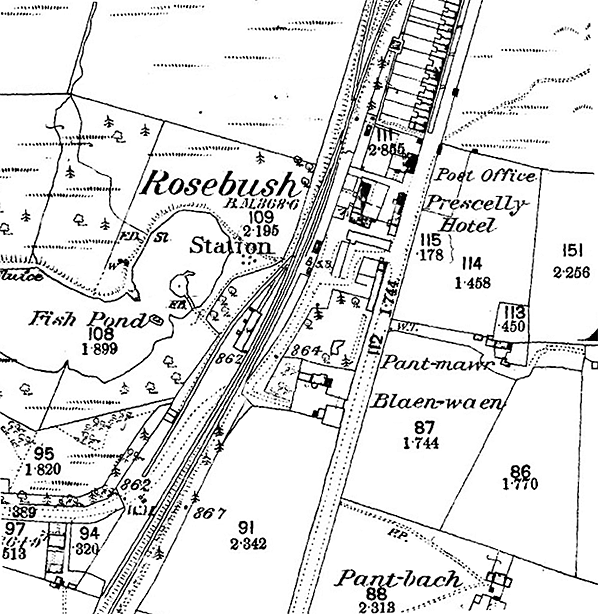
1889 1:2,500 OS map shows the original layout of Rosebush station before the extension to Letterston was opened in 1895. There was a platform on the up side; no building is shown here but the painting above shows that there was one. The original signal box by McKenzie & Holland is shown at the south end of the platform. The goods yard is on the down side; it has two sidings with a 1-road engine shed between them. The line to Rosebush quarry branches off just north of the station. The main line continues for a short distance towards New Inn. Construction of the line to Letterston had started by this time but stopped in August 1881 because the contractor Appleby & Lawton had not been paid for a mile of formation already completed.
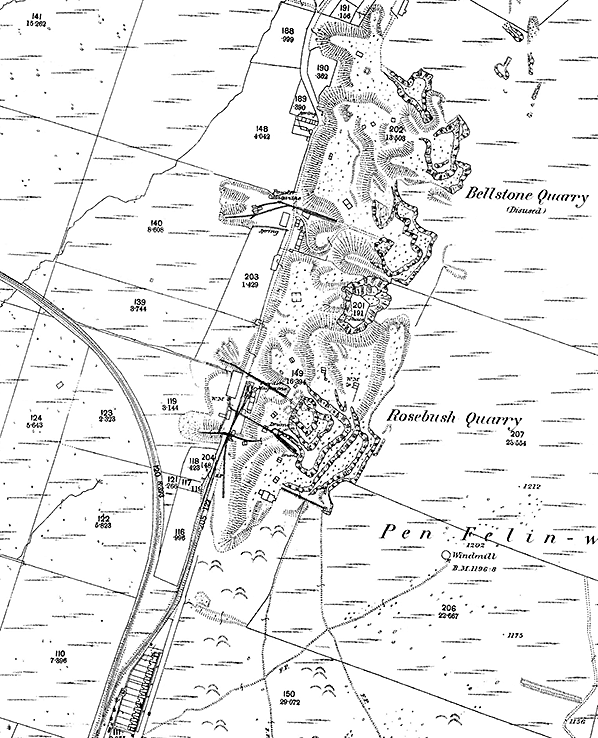
1889 1:2,500 OS map showing Rosebush and Bellstone Quarry and the connection to the Maenclochog Railway. This was a slate quarry and had provided material for the roof of the Palace of Westminster, presumably during the post-fire rebuild which commenced in 1840 and took 30 years to complete. It is said that slate from Rosebush and Bellstone was not of especially good quality for roofing but was excellent for building blocks. Today the old quarry is accessible by the public and its lakes popular for swimming. The engine shed is to the left of the magazine. Click here for a larger version.
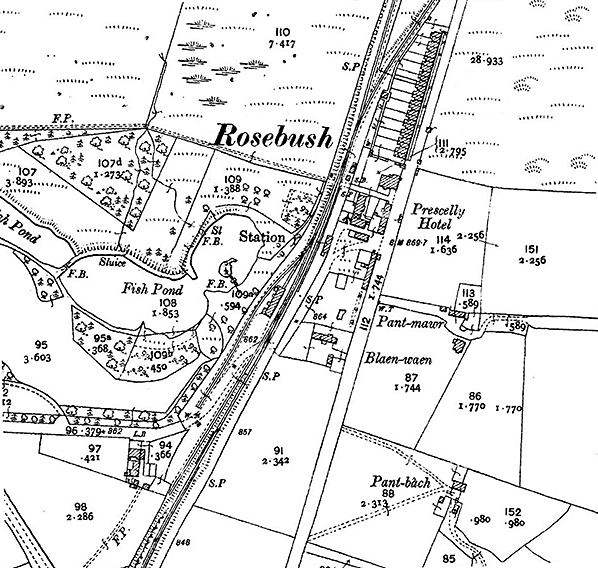 1907 1:2,500 OS map shows the layout of Rosebush station after the extension to Letterston had opened. The platform building is now shown. When the line was extended the original signal box was replaced with a Dutton & Co Type 3 box at the north end of the platform. Note the Fish Pond to the west (left) of the station. The Prescelly Hotel was built at Rosebush with the intention of it becoming a health resort and spa. This never came to fruition when analysis of the water in the 'fish pond' proved to be peaty with no medical properties. 1907 1:2,500 OS map shows the layout of Rosebush station after the extension to Letterston had opened. The platform building is now shown. When the line was extended the original signal box was replaced with a Dutton & Co Type 3 box at the north end of the platform. Note the Fish Pond to the west (left) of the station. The Prescelly Hotel was built at Rosebush with the intention of it becoming a health resort and spa. This never came to fruition when analysis of the water in the 'fish pond' proved to be peaty with no medical properties.old2.jpg)
Rosebush station and environs seen from across what is known as the ‘Fish Pond'. The date is thought to be around 1885. The long building right of centre is the locomotive shed with the station to its left, a reference point being the signal box in its pre-1895 location. The train, right, is not on the running line but on a dead-end siding to the west of the locomotive shed. There is a goods train in the station, possibly explaining the signal, right background, which is ‘Off’. Unfortunately the picture was taken from too far away for anything like a positive identification of the passenger train. There are a number of people milling around on the track and the carriage appears to be some kind of officers’ or inspection saloon. The locomotive, which is obviously named, looks like a saddle-tank. It may be one of the original Narberth Road & Maenclochog locomotives of which two still exist, one of which is thought to have carried the name ‘Ringing Rock’ which is English for Maenclochog.
Photo from John Mann collection old3.jpg)
Rosebush station looking north. The extension towards Letterston can be seen curving away westwards in the background and on a very obvious gradient. Adjacent to the hut on the left are trap points on the loop but no trap siding is present. The post-1920 picture (below) showing an auto-train tells us that the siding was in position by then so when it was installed is not known. It was not there in 1895 so the likely answer is it was installed for the 1920 reopening, therefore this photograph would date from the 1895-1917 period. The hut was probably for the storage of detonators. The signal box is the Dutton & Co Type 3 installed in 1895 to replace the original at the other end of the platform. The track branching from the loop served an engine shed and another siding branched from it, the points being just out of view. The loop and siding appear still to retain the original lightweight rails while the running line has heavier bullhead rails. The 'Off' signal and people sitting on the bench suggest that a train is due. The young lady on the track will get plenty of warning of audible warning of the train's approach. The siding branching off to the right and protected by the white gates led to Rosebush Quarry and was actually a Light Railway in its own right. The quarries, or at least Rosebush Quarry, are believed to have closed in 1914 but the siding still being present in this view is no indication of date as it could have remained in situ for some time. Odd items of railway origin can also still be seen dotted around the site. The advertisements for Pears soap could once be seen everywhere, together with what at the time were various unsubstantiated claims as to its benefits. Pears soap must have had something good about it, however, for it is still available today.
Copyright photo from John Alsop collection old4.jpg)
Rosebush station staff pose for the photographer circa 1910. The stationmaster is probably the gentleman seated in the centre with his wife standing alongside.
Photo from John Mann collection old5a.jpg) Rosebush station looking north-east with an auto-train present at the platform. Fortunately the history of the auto-coach is known, enabling us to date this view as sometime after July 1920 when the line was reopened yet again. To the left of the locomotive is a buffer-stop, giving the impression the nearest track is a dead-end siding. Fire buckets can be seen on the end of the station building and marked 'GWR FIRE'. On the hill, right background, what is thought to have been a wind-powered pump has disappeared, the Rosebush and Bellstone Quarries having closed in, it is believed, 1914. The locomotive is difficult to identify confidently but might be a 517 class 0-4-2T. It has a semi-open cab and what look like the toolboxes on top of the tanks, a distinctive feature of the 517 class, can just be discerned. The auto-coach is most interesting. It is No.116, one of the early slab-sided matchboard cars, and it began life as Diagram G steam rail-motor No.20 in August 1904 with engine unit No.0824. The '0' prefix was used to avoid any confusion with conventional locomotives which may have borne the same numbers, thus in essence it was a duplicate number list. The GWR designated its early steam rail-motors as either Branch or Suburban types, the main difference being extra luggage space in the Branch types although it seems the two types were often used indiscriminately. The Diagram G rail-motors were Branch types and comprised eight examples, Nos. 20-24 and 26-28 to Lot No.1063. The missing example, No.25, was an odd-man-out Diagram F rail-motor built at the same time as the Gs. The engine unit of No.20 had been at the end facing the camera. The rail-motor service on the Rosebush line operated between Clynderwen and Fishguard & Goodwick. Other rail-motor services in the area were Fishguard-Clarbeston Road and the Neyland branch. Like most of its breed, rail-motor no.20 was to have short life in its original form. Withdrawn in September 1919 it was immediately converted to Diagram A9 auto-coach No.116 as seen in this view. The rest of the batch were converted to auto-coaches, along with the odd No.25 which became auto-coach No.121, during 1920. All survived into British Railways days apart from No.116 which was withdrawn in November 1945. The reason for the early withdrawal, compared to the rest of the batch, is not known but the withdrawal date might suggest that it had been laid aside following war damage. The only recorded damage, as far as can be ascertained, was in December 1912 when, as rail-motor No.20, it was involved in a collision with
No.38 at Wrexham. Copyright photo from John Alsop collection old6.jpg)
The quarry engine shed c1935; the shed closed in 1912, two years before the quarry ceased production. The roofless shed was still standing in the 1980s although its present state is not known. Some quarry buildings were heavily robbed of stone by the district council in 1991. A large roofless dressing shed is still standing.
Photo
from Roger Griffiths collection
1.jpg)
Looking north-east at the grass-covered platform at Rosebush station in August 1967. The grass has either been mown or sheep have been grazing in the field.
Photo by Nick Catford 2.jpg)
The south end of Rosebush station platform in August 1967.
Photo by Nick Catford 3.jpg) Looking south-west along the trackbed in August 1967, the grass-covered platform is to the left.
Photo by Nick Catford 4.jpg)
The same view as the picture above in July 1974; the platform is now more
overgrown and difficult to see. Photo
by John Mann
5.jpg)
The north end of Rosebush station platform is in the beer garden of the Tafern Sync (which means ‘Zinc Tavern’), formerly the Station Hotel where a display depicting Rosebush station has been set up. There are more railway memorabilia inside the pub including a model of Rosebush station.
Photo by Adrian Black 7.jpg)
The south end of Rosebush station platform has not changed in 50 years apart from becoming more overgrown. (September 2016).
Photo by Roy Lambeth 8.jpg) The south end of Rosebush platform in September 2016. The platform edge is still clearly visible in places. The site is now a holiday caravan park.
Photo by Roy Lambeth 6.jpg)
LLooking north-east along the trackbed from Rosebush station in September 2016. The junction with the quarry line was at the end of the hedge on the right.
Photo
by Roy Lambeth
Click on thumbnail to enlarge
 Home Page Home Page
|
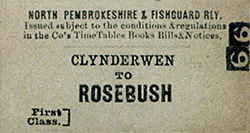 The station was provided with a single platform on the up side with a single-storey timber building with a pitched slate roof. A signal box by McKenzie & Holland was provided at the south end of the platform. There were two sidings on the down side to the south of the station with a 1-road engine shed between the sidings. To the north of the station a line ran into to Rosebush Quarry where there was another 1-road engine shed.
The station was provided with a single platform on the up side with a single-storey timber building with a pitched slate roof. A signal box by McKenzie & Holland was provided at the south end of the platform. There were two sidings on the down side to the south of the station with a 1-road engine shed between the sidings. To the north of the station a line ran into to Rosebush Quarry where there was another 1-road engine shed.
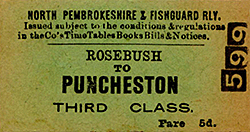 Rosebush station closed again on 8 January 1917 as the NP & F track was required as part of the war effort in France. After the war, the North Pembrokeshire branch reopened in stages. The line reopened form Maenclochog to Rosebush on 12 July 1920, as it was now a temporary terminus a run-round loop was provided. This was no longer required when line was extended to Puncheston on 14 November 1921 so it was removed, leaving a siding.
Rosebush station closed again on 8 January 1917 as the NP & F track was required as part of the war effort in France. After the war, the North Pembrokeshire branch reopened in stages. The line reopened form Maenclochog to Rosebush on 12 July 1920, as it was now a temporary terminus a run-round loop was provided. This was no longer required when line was extended to Puncheston on 14 November 1921 so it was removed, leaving a siding.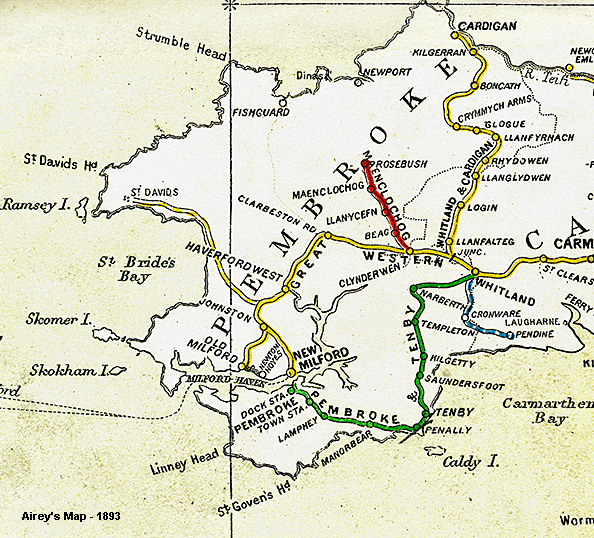
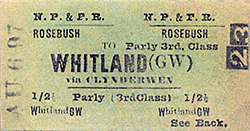
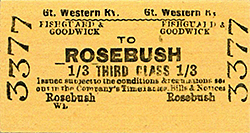
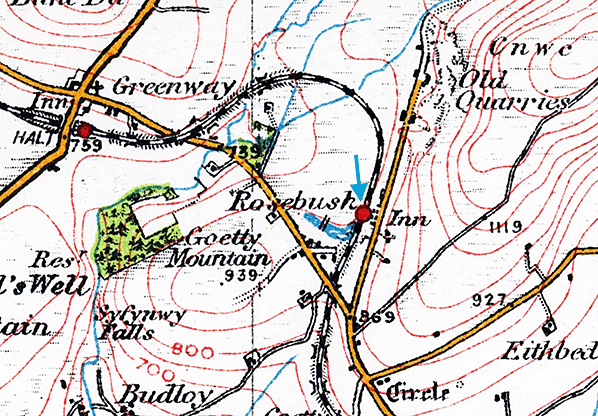
thumb9.jpg)
thumb10.jpg)
thumb14.jpg)
thumb13.jpg)
thumb12.jpg)
thumb11.jpg)
